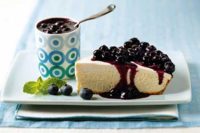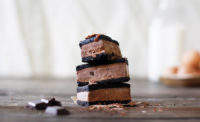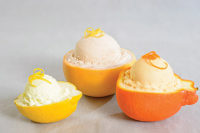Texturally speaking, “ice cream” is something of a misnomer. Yes, consumers expect the frozen treat to be creamy; but any hint of actual iciness — either in the scoop or on the palate — qualifies as an unmistakable quality flaw.
Yet, many of these same consumers are now demanding ice cream with less sugar, cleaner labels, healthier nutritionals and even, in some cases, no actual cream (or dairy, for that matter). So frozen dessert developers are finding it harder to keep the textural balance tipped toward the creamy side of the equation when nudging formulations toward what consumers consider more healthful.
“Can we ever truly replace the satisfaction of indulging in a properly formulated traditional dairy ice cream?” asked Aaron Chip Venables, principal scientist, ice cream and fluid dairy for DuPont Nutrition & Health, Ewing, N.J. “It’s unlikely. But with innovative formulating, it is possible to create alternative frozen desserts with textures that meet consumers’ expectations.”
Alternative options
“Alternative” is fast becoming the norm in frozen desserts, as the diversity within supermarket freezer cases begins to mirror that of the shoppers who shop them. As Bob Loesel, research development manager for Minneapolis-based Cargill, noted, “When it comes to frozen desserts, today’s consumers are increasingly looking for more than just an indulgent treat.”
Namely, they’re looking for indulgent treats that are “better for you” at the same time.
“One of the biggest trends in the marketplace is the proliferation of high-protein, lower-calorie ice creams,” Loesel observed. “There’s also plenty of pressure to clean up ingredient decks with an eye toward replacing things like mono- and diglycerides with more label-friendly options.”
Jennifer Stephens, vice president, marketing, Fiberstar, River Falls, Wis., remarked on the proliferation of plant-based options.
“Nondairy frozen products with soy and rice milk bases have been on the market for over a decade,” she said, “but ever since the alternative drinkable milk category exploded, you find almost every dairy-milk alternative in the ice cream section. Ice cream bases are made using cashew, coconut, hemp, almond.”
Stephens also noted a tendency among frozen dessert brands to publicize their better-for-you credentials on what she termed “the packaging’s front real estate,” using bright graphics and large, bold type to all but shout how many — or, more accurately, how few — calories are in the whole pint.
“These calorie totals can range from 100 to 300,” she said, “which may be equivalent to a tasty candy bar. That means people can now eat their pint in one sitting and feel less guilty.”
Great expectations
“Consumers still expect a good-for-you product to have a smooth, creamy texture and to taste great — so it’s important to find ingredients that meet those expectations,” said Christine Addington, senior dairy technical service specialist for Cargill.
In addition to smooth and creamy, other textural benchmarks consumers expect in frozen desserts include density, body, elasticity and scoopability. The latter is important, Addington explained, because consumers don’t want to wait for their ice cream to soften to a desirable texture.
As for elasticity, a certain amount is desirable, but too much “can be a giveaway that the product has been overstabilized with gums,” noted Kurt Villwock, Ph.D., director of R&D for Fiberstar. “A nice, crumbly, shorter texture is generally more preferred.”
Body and density depend on factors such as melt rate and overrun — the extent to which the volume of an ice cream exceeds that of the mix from which it was made, thanks to air whipped in during the freezing process.
“An overrun that’s not too high and not too low will provide the best eating and scooping qualities,” said Paul Ruger, group manager, ice cream/fluid dairy for DuPont Nutrition & Health, New Century, Kan. “And a moderate melt rate will allow for a good eating experience.”
Loesel highlighted the importance of what he called “storability.”
“Consumers expect their ice cream to retain its creamy consistency through multiple trips in and out of the freezer,” he explained. “However, exposure to temperature fluctuations” — a phenomenon called heat shock — “can do a number on texture, leaving behind a sandy, gritty mouthfeel. You need a product that can retain its texture over its entire lifespan, despite those inevitable temperature variations.”
What’s going on in there?
Formulating a product to display such textural durability doesn’t happen by accident. Perhaps, said Brian Surratt, senior scientist with Cargill, that’s because frozen desserts are one of most complex food systems that have been created.
“They contain all three phases — solid, liquid and gas — which makes it extremely challenging to manipulate critical ingredients like fats, proteins and sugars,” he explained. “To be successful, you need a deep understanding of how each component interacts with the water, fat and air inherent in the system.”
The manner in which fat globules in the emulsion spread and aggregate near air cells — sometimes flocculating and coalescing as clumps — plays a critical role in the product’s structure, for instance. As the mix freezes, proteins that emulsify the fat desorb from the fat’s surface, allowing the fat to destabilize and partially coalesce. This then becomes a mechanism to help stabilize the air added to the product.
“The fat and the air together greatly influence the ice cream’s body,” Ruger pointed out. “Think of fat as the mortar and air cells as the brick. Fat is important in ice cream as it adds the expected richness, body, texture and mouthfeel.”
Equally important are the mix’s dissolved solids, most often sugars, which stabilize free water by holding onto it in a way that prevents it from freezing into jagged, icy crystals.
What could go wrong?
This critical function is known as freezing-point depression, and it’s an asset: A lower freezing point means that at a given temperature, you will get less ice and more water — and, therefore, a softer ice cream texture, Villwock explained.
The problem is that whenever we reduce the number of sugar molecules in an ice cream mix — as happens when we replace sugar with a much smaller percentage of high-intensity sweeteners — we reduce the mix’s level of dissolved solids and, in turn, raise its freezing point, making it easier for those pesky ice crystals to form.
“That impacts texture,” said Ivan Gonzales, marketing director, dairy for Ingredion Incorporated, Westchester, Ill. “So when we discuss sugar reduction in ice cream, we need to compensate for those lost solids to minimize the texture impact and make sure that ice crystal formation remains within acceptable parameters for a good overall texture.”
Villwock noted that formulators can lower freezing point with any dissolving solid, not necessarily a sugar. But it does have to be highly soluble in cold conditions. So despite being an ostensibly soluble solid, dairy’s natural lactose — only “borderline” soluble in a cold mix serum, he said — will precipitate out and create a sandy effect.
Substituting long-chain polymers for sugar is no panacea, either, Ruger added, as such polymers tend to make ice cream thicker and chewier and can inhibit flavor release.
“Thus, choosing solids to replace sugar that closely mimic its properties is key,” he said.
Protein problems
And this is just the trouble we face when reducing an ice cream’s sugar content. Start adding protein, substituting plant milk and more, and the texturizing task grows exponentially more complicated.
“Modifying any ice cream formulation with nontraditional ingredients might easily affect important properties such as scoopability, smoothness, creaminess and body,” said Andy Estal, director of customer technical service, Americas region for Beneo, Parsippany, N.J. “Producing an on-trend ice cream that also delivers great sensory properties is very tough these days.”
Consider the introduction of protein. True, some proteins confer coveted functionality.
“Proteins require water to hydrate and, typically, if used in higher concentrations, create higher viscosity,” Gonzales explained. “And in some cases, depending on the type of protein, they may have foaming or emulsifying characteristics.”
Villwock agreed.
“Protein can give warmth and richness — up to a point,” he said. “If levels get too high, textures may suffer, becoming chalky or gritty.”
Just how chalky or gritty turns on the protein type, with dairy being generally more soluble — and thus more conducive to smoothness — than plant-based options.
“Many nondairy proteins can impart a significant amount of mix viscosity and disrupt processing efficiencies,” Venables said.
Plant-based glitches
Another plant-based glitch: changes in freezing point. Because nondairy systems don’t have the same balance of sweeteners and milk solids-not-fat (MSNF) as traditional ice cream, formulators often have to add sugar or other dissolved solids to keep the freezing point suitably low.
“Failure to do so will result in crumbly eating textures, hard serving textures and poor air cell stability,” Venables said. “In addition, these formulations can result in excessive fat agglomeration, resulting in poor meltdown properties and a greasy mouthfeel.”
Stabilizers such as carrageenan are excellent at preventing whey-off by interacting directly with dairy proteins, but are not necessarily a panacea for plant-based offerings.
“Those same interactions may not be taking place in plant-based systems due to differences in chemistry,” said Kyle Bailey, technical services manager, North America for CP Kelco, Atlanta. “This can impact texture upon freezing and throughout frozen storage.”
And don’t forget shrinkage!
“We see containers of nondairy frozen desserts that’re only three-quarters full, with the dessert pulling away from the sides,” Loesel said. “That’s a turnoff for consumers. So to minimize shrinkage, product developers need to stabilize a little differently. There’s still work to be done in this space, but ingredients like glycerin and fibers offer possible solutions.”
Clean texture
Traditional solutions ran to mono- and diglycerides, propylene glycol monostearate, polysorbates, carboxymethyl cellulose, microcrystalline cellulose, cellulose gel, cellulose gum and the aforementioned carrageenan. But to the extent that clean labeling renders such ingredients unwelcome — and by most definitions, it does — “we should expect textural and processing differences,” Venables said.
For example, removal of mono- and diglycerides could compromise mix structure at the filler and lead to what Venables called “sloppy filling” — an especially vexing issue in frozen novelties. The exclusion of propylene glycol monostearate usually means reduced freeze/thaw stability, as it helps keep ice crystals small. Loss of carrageenan is problematic in resale mixes because it can allow for excessive whey-off. And without cellulose gel, you can expect both a less-indulgent eating experience and shrinkage.
Of course, this doesn’t mean that formulators can’t produce clean-label frozen desserts with appealing textures and passable stability.
“But,” said Loesel, “it’s important to remember that it often takes multiple ingredients to replace the tried-and-true options.”
Functional fibers
Among those ingredients are functional fibers such as pectin, which is considered to be a clean-label ingredient, Bailey said. Frozen dessert developers turn to pectin for stabilization and gelling, and specialty pectins can mimic fat by bolstering smoothness and creaminess in reduced-fat formulations.
Villwock noted that his company’s Citri-Fi, a natural citrus fiber produced as a byproduct of juicing, can replace some commonly used emulsifiers, hydrocolloids and freeze-thaw protectors. A patented washing and physical treatment effectively “opens” the fiber’s structure, exposing its large surface area and unlocking its capacity to hold water — up to seven to 10 times its weight.
And because the fiber’s emulsion mechanism differs from the classic oil-droplet micelle model, it can emulsify without the need for high-shear. However, high shear — as occurs during ice cream homogenization — further increases the fiber’s surface area, creating the potential for high mix viscosities. Even better, the ingredient appears on labels as citrus fiber, dried citrus pulp or citrus flour.
Then there’s chicory root fiber, also known as inulin. Valued nutritionally as a prebiotic soluble fiber with only 2 calories per gram, it earns its functional keep in frozen desserts by providing a smooth, creamy mouthfeel and mild, sucrose-like sweetness with no off-tastes and minimal impact on properties such as freezing-point depression or scoopability.
Addington noted that her company’s line of Oliggo-Fiber chicory root fibers offers options with varying fiber content, sweetness, molecular weight, solubility, polymerization and branching structure. Some mimic fat for a creamy or milky texture; others function more like sugar by depressing freezing point; still others act as bulking agents in reduced-sugar applications.
Starches and syrups
Starches and syrups can help, too.
“Rice starch provides a way to reduce calories by replacing sugar or fat and providing a smooth, creamy texture, neutral taste and bright white color not seen from other botanical sources of starch,” Estal pointed out. “And rice starch contributes to improved freeze-thaw stability because of its unique particle structure.”
Gonzales noted that tapioca starches and flours enjoy “very good acceptability and perception with consumers, and can help replace some hydrocolloids while still providing good viscosity, mouthfeel and stabilization.”
And tapioca syrup is getting more exposure in the freezer case, Addington said, particularly in plant-based frozen desserts.
“Non-GMO in origin, it’s an ingredient that consumers recognize and understand,” she said.
Sugar alcohols
Another syrup that’s useful as a clean texturizer is maltitol syrup. Gonzales touts his company’s Maltisweet IC maltitol syrup for helping reduce sugar content while still providing adequate solids for a good freezing-point depression and prevention of ice crystal formation.
As a sugar alcohol, maltitol is in good company, as a number of such polyols are gaining traction for texturizing purposes in clean-label frozen desserts.
In reduced-sugar applications, erythritol — a natural zero-calorie bulk polyol — can depress freezing point three times more than sugar, thanks to a molecular size about one-third of sugar’s.
“That higher effect on freezing point depression helps soften reduced-sugar ice creams, creating the scoopable texture consumers crave,” said Ravi Nana, polyols technical service manager at Cargill.
And Estal praises isomalt as an excellent sugar replacer in ice cream thanks to its sucrose-like sweetness, clean aftertaste, lack of cooling effect and neutrality on freezing-point depression.






